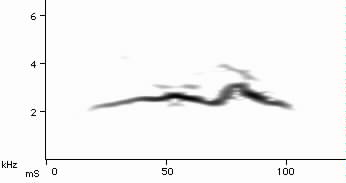
presumed Rose-breasted Grosbeak nocturnal flight calls
Fig.5. New York September 11, 1992 (WRE).
Fig.6. New York September 12, 1992 (WRE).
Fig.7. New York September 11, 1992 (WRE).
Fig.8. New York September 12, 1992 (WRE).
Fig.9. New York September 11, 1992 (WRE).
Fig.10. New York September 12, 1992 (WRE).
Fig.11. Alabama April 17, 1990 (WRE).
Nocturnal flight call sequences:
4. New York September 12, 1992 12:19AM EDT (WRE).
5. New York September 12, 1992 12:02AM EDT (WRE).
6. New York September 12, 1992 1:13AM EDT (WRE).
7. New York September 12, 1992 1:18AM EDT (WRE).
8. New York September 12, 1992 3:17AM EDT (WRE).
9. New York September 12, 1992 1:06AM EDT (WRE).
10. New York September 11, 1989 2:02AM EDT (WRE).
Discussion:
In night migration, as experienced in fall in central New York State, Rose-breasted Grosbeaks often sound as though they are passing in small groups of 3-5 individuals. There is frequently a calling variation within these groups that is suggestive of immature and adult birds migrating together - the adults giving more pure-toned calls (e.g., Fig.9) and the immatures somewhat harsher sounding notes (e.g., Fig.10). The most harsh and modulated notes (e.g., Fig. 6 & 7), however, may be a regular but less common variant given by adults. Whereas variations like fig. 9 have been substantiated by diurnal recordings (e.g., Fig. 1), the modulated Fig. 6 & 7 variants have not been recorded during the day. These variants are presumed to be from night-migrating Rose-breasted Grosbeaks because they invariably occur in close temporal and spatial association with other Rose-breasted Grosbeak calls at night.